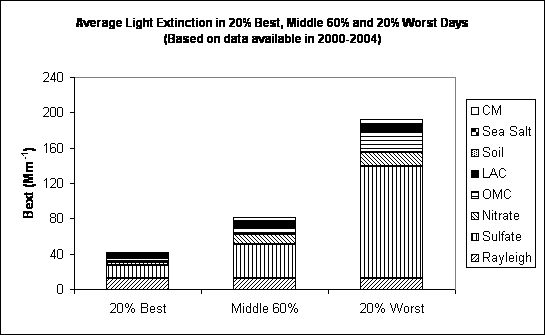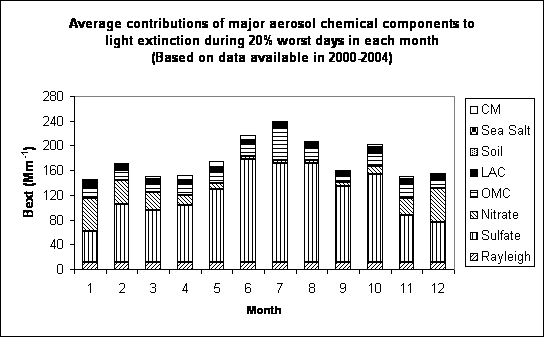
BRIG1 (Brigantine, NJ, Lat. 39.465, Long. -74.4494, Alt. 5)
Based on the regional haze rule version 2, 5 years of complete aerosol data are available in Brigantine NWR during the baseline period of 2000 - 2004. As shown in Figure 1, the overall average total light extinction coefficient (Bext) is 96.7 Mm-1 (Visual Range ~ 56 Km; Deciview ~ 21). The average PM2.5 mass concentration is 10.4 mg/m3. The average contributions of the major aerosol components to Brigantine haze are particulate sulfate 53.7%, nitrate 11.1%, organic matter (OMC) 11.5%, elemental carbon (light absorbing carbon, LAC) 4.6%, fine soil 0.5%, sea salt 1.4%, and coarse mass (CM) 4.7%.

Figure 1 Average contributions of major aerosol chemical components to light extinction (Based on data available in 2000-2004)

Figure 2 Average contributions of major aerosol chemical components to light extinction in 20% best, middle 60% and 20% worst days (Based on data available in 2000-2004)
As Figure 2 indicates, the average light extinction coefficient during the 20% worst days is 192.7 Mm-1, which is about 4.5 times of the value of 42.4 Mm-1 during the 20% best days and 2.4 times of the value of 81.9 Mm-1 during the middle 60% days. Sulfate is the largest aerosol contributor to light extinction during the 20% worst days, with a contribution of ~ 66%.
Figure 3 suggests that the highest occurrence of the 20% worst days happened in June and July, in which ~ 40-50% of the sampling days are the 20% haziest days at Brigantine. As shown in Figure 4, in the 20% worst visibility days, sulfate is the largest aerosol contributor to haze except in January, during which nitrate is the largest aerosol contributor to haze.

Figure 3 Percentage of sampling days that are 20% worst days in each month (Based on data available in 2000-2004)

Figure 4 Average contributions of major aerosol chemical components to light extinction during 20% worst days in each month (Based on data available in 2000-2004)